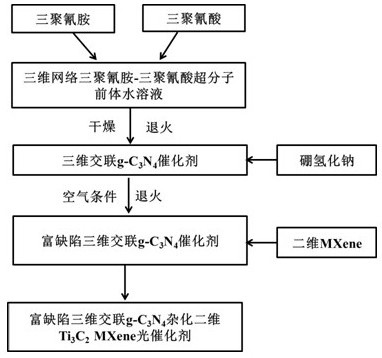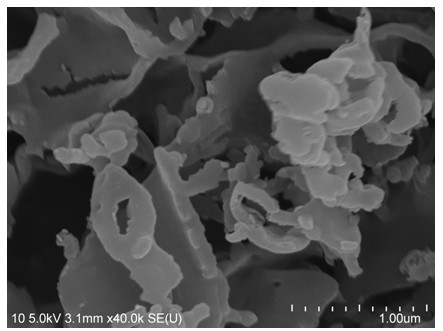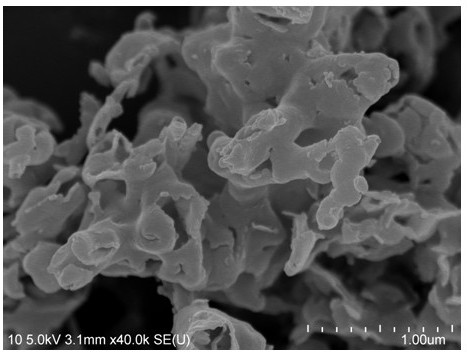Preparation method of defect-rich three-dimensional cross-linked g-C3N4 hybrid two-dimensional Ti3C2MXene photocatalyst
A three-dimensional cross-linking, photocatalyst technology, applied in the field of preparation of visible light catalytic materials, can solve the problems of easy stacking, limited practical application, difficult separation, etc., and achieve the effects of high charge transfer, good visible light response, and large specific surface area.
- Summary
- Abstract
- Description
- Claims
- Application Information
AI Technical Summary
Problems solved by technology
Method used
Image
Examples
Embodiment 1
[0028]First, dissolve 50mmol melamine and 50mmol cyanuric acid in 100mL deionized water and stir for 12h; then transfer the stirred solution to a glass dish and dry at 60°C for 12h; grind the obtained precursor and anneal at 550°C After 4 hours of treatment, the three-dimensional cross-linked g-C 3 N 4 Sample; 1.0 g of three-dimensional cross-linked g-C 3 N 4 Mix the sample with 0.05g sodium borohydride evenly, and anneal at 300°C for 1 hour to obtain a yellow defect-rich three-dimensional cross-linked g-C 3 N 4 Sample; take 2.0g defect-rich three-dimensional cross-linked g-C 3 N 4 The sample was dispersed in 100mL hydrochloric acid solution (1mol / L), after ultrasonic treatment, washed and dried to obtain the protonated defect-rich three-dimensional cross-linked g-C 3 N 4 sample.
[0029] Take 1.0g of lithium fluoride and slowly dissolve it in 40mL of hydrochloric acid solution with a concentration of 5mol / L, stir for 10min to fully dissolve it, and slowly add 3g of Ti...
Embodiment 2
[0032] First, dissolve 10mmol melamine and 10mmol cyanuric acid in 100mL deionized water and stir for 12h; then transfer the stirred solution to a glass dish and dry at 60°C for 12h; grind the obtained precursor and anneal at 600°C After 4 hours of treatment, the three-dimensional cross-linked g-C 3 N 4 Sample; 1.0 g of three-dimensional cross-linked g-C 3 N 4 Mix the sample with 0.05g sodium borohydride evenly, and anneal at 400°C for 1 hour to obtain a yellow defect-rich three-dimensional cross-linked g-C 3 N 4 Sample; take 2.0g defect-rich three-dimensional cross-linked g-C 3 N 4 The sample was dispersed in 100mL hydrochloric acid solution (1mol / L), after ultrasonic treatment, washed and dried to obtain the protonated defect-rich three-dimensional cross-linked g-C 3 N 4 sample.
[0033] Take 3.0g of lithium fluoride and slowly dissolve it in 40mL of hydrochloric acid solution with a concentration of 2.5mol / L, stir for 10min to fully dissolve it, and slowly add 1g of...
Embodiment 3
[0036] Take 10 mg of defect-rich three-dimensional cross-linked g-C prepared in Example 1 3 N 4 Hybridized 2D Ti 3 C 2 The MXene photocatalyst was dispersed in 80mL of RhB solution with a concentration of 20mg / L, stirred in dark light for 30min, turned on the light source, timed, and took samples and filtered at specific time points for analysis. After 25min of reaction under visible light, the degradation rate of RhB was 100%. See the effect for details Figure 4 .
PUM
 Login to View More
Login to View More Abstract
Description
Claims
Application Information
 Login to View More
Login to View More - R&D
- Intellectual Property
- Life Sciences
- Materials
- Tech Scout
- Unparalleled Data Quality
- Higher Quality Content
- 60% Fewer Hallucinations
Browse by: Latest US Patents, China's latest patents, Technical Efficacy Thesaurus, Application Domain, Technology Topic, Popular Technical Reports.
© 2025 PatSnap. All rights reserved.Legal|Privacy policy|Modern Slavery Act Transparency Statement|Sitemap|About US| Contact US: help@patsnap.com



